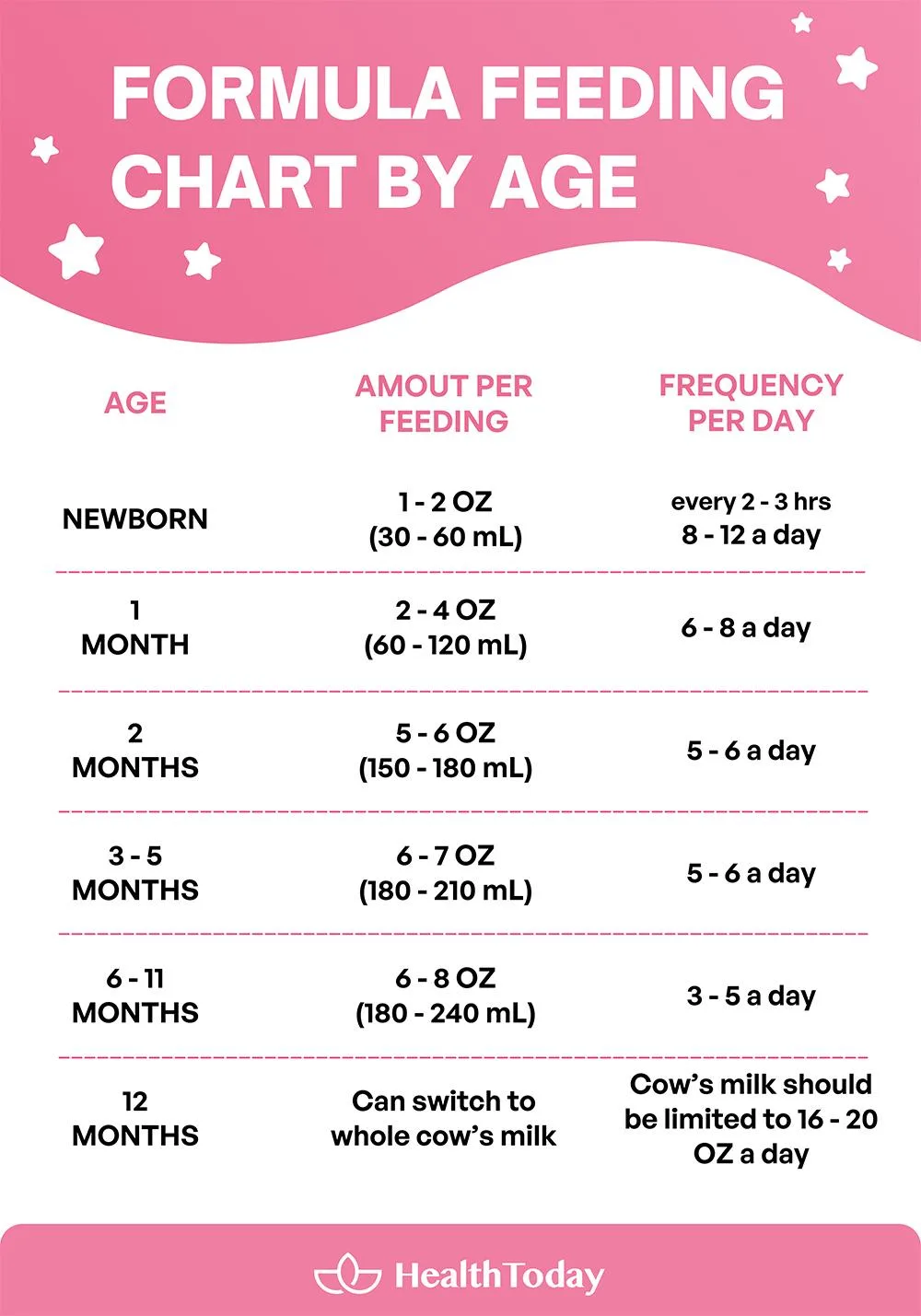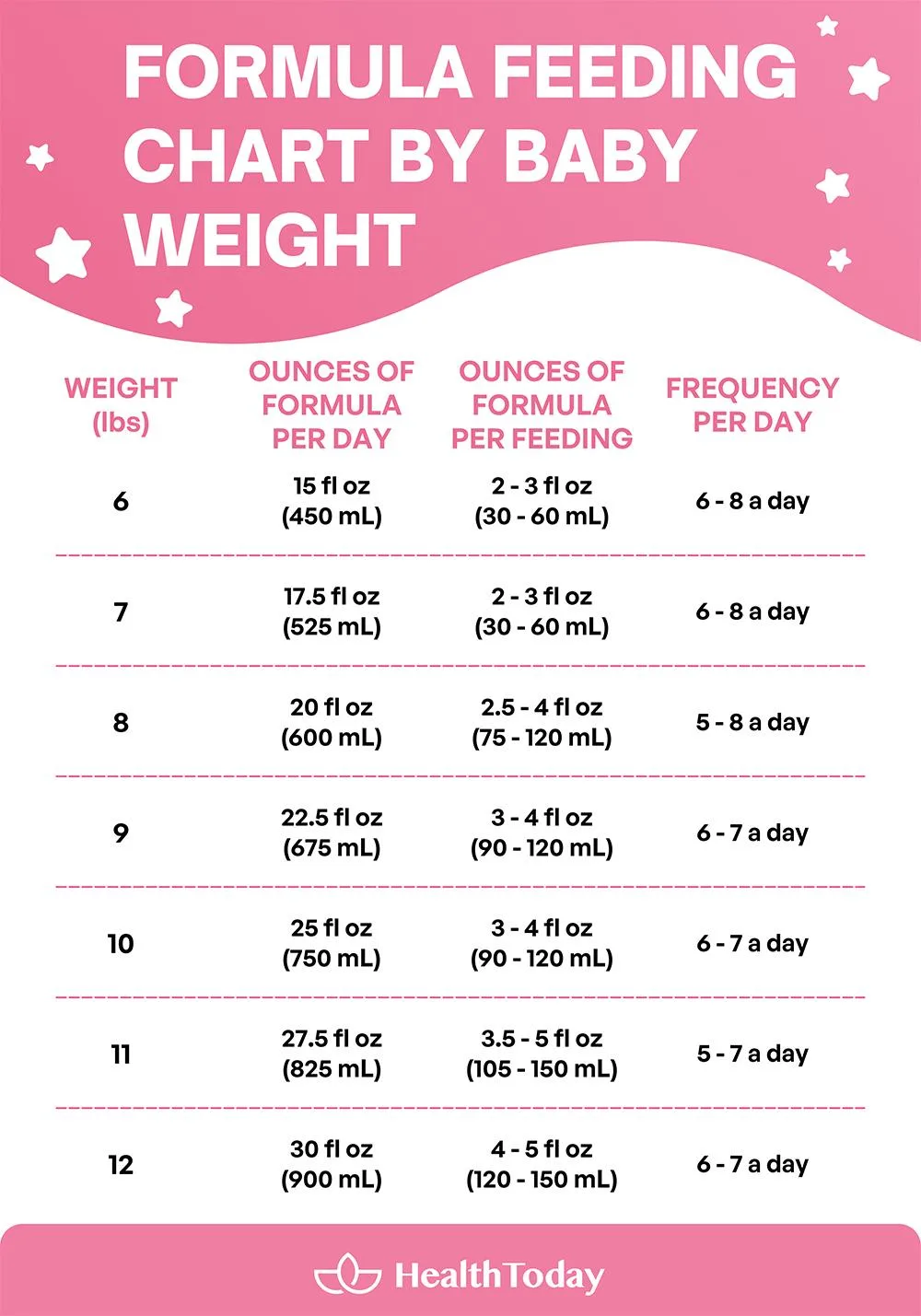Table of Contents
The amount of nutrition and food the baby requires varies individually. There are no hard and fast rules or science behind it. But all new parents must know that giving too little or too much food is not good.
The same applies to it; it depends on age, hunger cues, and several other factors. To assist you, here is a comprehensive guide on how much formula a newborn and baby should drink and additional important information.
How much formula and how often to feed my baby?
Generally, newborns should be fed on demand. The on-demand feeding is when you feed after noticing the hunger cues (2). This will allow the newborn to develop the habit of infant formula milk generally. Also, with time they may increase their intake. Moreover, it’s one of the best approaches to fulfilling the nutritional requirements.
Additionally, a study by the University of Essex has found that feeding your baby on demand may contribute to higher IQ’ (3). You can slowly learn to notice the hunger signal discussed below to initiate and build on-demand feeding.
Signs that your baby is hungry
Here are different baby’s appetite cues that may indicate that the baby is hungry (4, 5):
- The baby may move their fist toward the mouth.
- Also, they may turn toward the breast.
- They may also become more active and alert.
- One of the most common signs is sucking on hands or lip-smacking. Also, it may include puckers or licks lips.
- Notice their hands; if clenched, the baby may be hungry.
Some of the most advanced hunger cues in babies after six months can be (5):
- The baby may point or reach out to the food.
- They may open their mouth wide if offered a spoon, bottle, or food.
- The baby may get excited when they see food.
- They may make sounds or signs to tell you that they are hungry.
Also, crying is often the last sign of hunger. It is not recommended to wait until this point, as the baby may become very difficult to console. Therefore, try to identify the initial hunger cues. Hunger cries are usually short, low voices and are separated by intervals (6). Moreover, hunger cries have a pattern of rising and falling and may become more frantic or angry over time
So, identifying all these hunger cues can be very useful for feeding on demand.
How much formula should a newborn drink?
According to the CDC, a newborn can have 1 to 2 ounces of formula per feeding in the first week of formula milk (7). Gradually, it can be increased to 3 to 4 ounces of formula at each feeding by the end of the first month (7).
Formula-fed babies may have to be fed every 2 to 3 hours in the first few days (7). Then it may change to about every 3 to 4 hours for most infant formula-fed babies in a few weeks and months (7). By the sixth month, the baby may have 6 to 8 ounces of formula (180–240 mL) at each of 4 or 5 feedings in 24 hours (7).
Formula feeding chart by age

You can also feed according to the baby’s age (8):
- 1 month: 2 to 4 ounces with six to eight feedings per 24 hours
- 2 months: 5 to 6 ounces with five to six feedings per 24 hours
- 3 to 5 months: 6 to 7 ounces with five to six feedings per 24 hours
Formula feeding chart by baby weight
Feeding by baby’s weight is also one popular method of feeding. According to some experts, your baby may take about 2½ ounces (75 mL) of infant formula daily for every pound (453 g) of body weight (9).
But, this also depends on individual baby needs. They will show signs of hunger, and you should try to notice them. Moreover, consult your pediatrician about how much formula milk feeding is advisable.

Formula feeding schedule for newborns and babies
Like breastfed babies, formula-fed newborns should eat on demand. On average, that’s about every 2 to 3 hours. A typical feeding schedule may look like this:
- Newborn: every 2 to 3 hours
- At 2 months: every 3 to 4 hours
- At 4 to 6 months: every 4 to 5 hours
- At 6+ months: every 4 to 5 hours
You must know that breast milk differs from baby formula milk. For example, breast milk digests more quickly than formula milk (10). As a result, the feeding schedule is different. You must discuss the schedule and amount with the child’s doctor if you are feeding formula milk. Also, after 4- 6 months or older, if your baby starts to introduce solids, you may need to adjust the schedules (11).
To set a feeding schedule for babies, slowly let them get used to the feeding time. There is no fixed rule for it.
You can develop a habit that is beneficial for you and your baby. For example, if your baby wakes up after 5 hours of feeding and you feed at 9 pm, they will wake up at 2 am. But if you feed at 11 am, they may get up at 4 am, which is a more suitable time.
On-demand feeding is the most ideal and natural one. Also, it may be beneficial for the baby to prevent being overweight and may have a higher IQ in the future(12)(13). On the other hand, structured feeding (paced feeding) is also a popular method but not recommended much. Moreover, feeding on the baby’s demand is easier, but due to the mommy’s schedule and timing, it may sometimes be difficult.
In sum, your schedule must be developed by identifying your baby’s feeding needs.
Infant formula feeding guide
There are many types of formulas in the market (14). Proper knowledge of all kinds will help you initiate feeding. Also, discuss the formula types with your healthcare provider for the best advice.
Tips for Choosing a Formula:
Here are the different types of popular formulas:
Powder: This is one of the most affordable types. As the name denotes, it’s powder and may not need refrigeration. But, once you have mixed it with water, you should refrigerate it.
Concentrate liquid: Like the powder form, the concentrated liquid should also be mixed with water. Once the package is opened, it must be refrigerated.
Ready-to-use formula: This formula is pre-mixed and ready to use. Also, these are the most expensive ones that come in handy when you want to avoid mixing and preparation.
Steps for feeding:
- You should always check the expiration date of the formula and never use it past the date.
- Mix in according to instructions. Too little water or too much water can disrupt the ratio.
- You should always use clean water or boil it before mixing.
- Transfer the formula to a clean and sterilized bottle.
- Check the temperature of the formula milk.
- Hold your baby in the most comfortable feeding position for both of you.
- For correct bottle feeding posture, hold the baby in a semi-upright position. Hold the bottle horizontally and ensure that only the teat is filled with milk. Also, the top of the teat should be placed below the nose for comfortable feeding (15). In addition, you can burp them after feeding (16).
- It’s recommended to take the formula amount that your baby mostly has. If you have a leftover formula, throw it away and don’t save it for the next feeding.
- Also, follow the natural hunger cues of the baby, and feed responsively (15). Gradually, you and the baby will build the habit of formula feeding.
Note: Don’t leave the baby with the bottle; there can be a risk of choking.
Signs that your baby is getting enough formula
Here are some signs that may tell you that your baby is getting enough formula:
- There may be around 6 wet diapers per 24 hours (17).
- The baby is satisfied and happy.
- There is a gradual weight gain.
If your baby gets less than the required formula and nutrition, it may hinder growth and development (18, 19). So, discussing it with the doctor is very important.
Signs that your baby is getting too much formula
Sometimes the feeding with the bottle may go overfeeding easily (20). Overconsumption has some small signs. Here are some signs that tell that your baby may be getting too much formula:
Usual spit-ups: Spit-ups are common, but spit-like vomits are not. So, if you notice large or frequent spit-ups, it may be a sign of overfeeding (21).
Excessive weight gain: Gradual weight gain is important and normal. But if you notice rapid weight gain, discuss it with the doctor (22).
Tummy issues: Excessive feeding can also cause tummy pain and problems. If the baby lifts their legs or tummy or seems tense, they may have pain (23).
Noticing unusual signs around feeding can help you determine less or overfeeding. Also, consulting your doctor and determining the right feeding quantity and times according to age and weight will greatly help you.
Formula feeding tips from experts
Here are some tips for feeding:
- Here’s a thumb rule: Babies generally show signs when starving (4, 5). Also, they show signs of fullness (5). So, don’t force them to complete the bottle if they resist. Let them follow their cues.
- Babies’ cries have different meanings (6). Don’t always assume that every cry is linked with the feeling of hunger. For example, the baby may cry if the diaper is wet, need attention, or feel hot or cold. There can be several other reasons.
- There are some periods of growth spurt in the baby (24). During this time, the baby requires more feeding than usual. It can occur in various weeks or months. So, discussing it with your doctor is important.
- Sometimes, the baby needs a pacifier or other toys to suck (25). If you notice any cravings, you can offer them that. This will help you avoid overfeeding.
- Mixing water and formula in the ratio mentioned in the instruction is very important. Over-diluting or less dilution can decrease or increase the calorie count. Also, it could be dangerous due to the risk of water intoxication (26).
- You can try to create a wholesome environment around feeding. You can place a pillow or toys or create a silent zone. This helps the baby and mother to enjoy the feeding time.
- Always support the baby’s body during feeding. Choose the most comfortable positions.
- You should always wash your bottle, use clean water, and follow hygiene around feeding (27). Also, wash your hands before mixing the infant formula and water.
These smart and hygienic tips are really useful. So, take your time and arm yourself with the right knowledge with the help of doctors.
Summary
Parenthood is thrilling, wholesome, and has sweet challenges. It’s okay to be confused, ask questions and research what’s best for your baby. When it comes to feeding with formula, it’s best to feed on demand. However, it would be best to consider factors like age, weight, breastfeeding, and introduction of solids.
Discussing all these factors with your healthcare provider or pediatrician for the best advice is most suitable. Also, you and your baby will gradually build the habit of feeding. Notice the signs during and after feeding, which will help you read your baby’s mind. Plus, follow safe and hygienic practices and feed the baby comfortably. Finally, consider all the above points and have a happy time feeding the baby.

















Comments
0